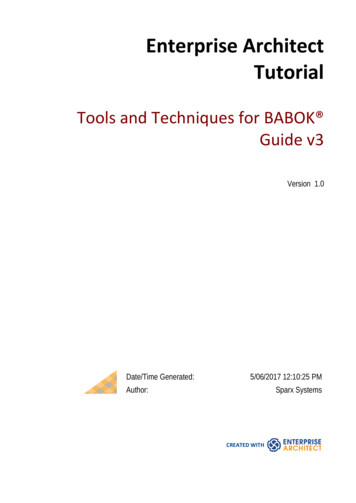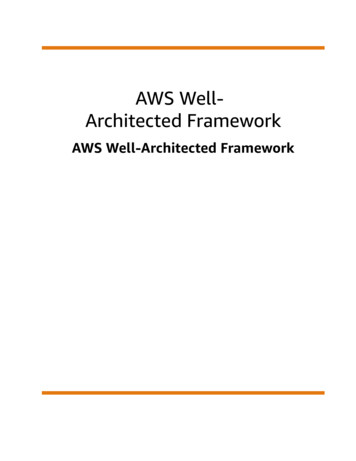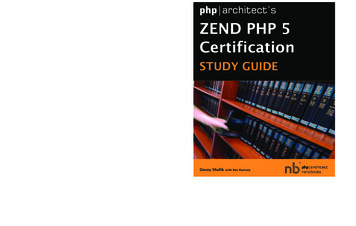
Transcription
Enterprise ArchitectTutorialTools and Techniques for BABOK Guide v3Version 1.0Date/Time Generated:5/06/2017 12:10:25 PMAuthor:Sparx SystemsCREATED WITH
Help System - Tools and Techniques for BABOK Guide v3(c) Sparx Systems 2015Page 2 of 225 June, 2017Created with Enterprise Architect
Help System - Tools and Techniques for BABOK Guide v35 June, 2017Tools & Techniques for BABOK Guide v3The Tools & Techniques for BABOK Guide v3 is a guide to the Business Analysis Body of Knowledge, published bythe global body, the International Institute of Business Analysts (IIBA ). This body of knowledge has beenincorporated into Enterprise Architect as an online resource, that you can use as an agile collaboration solution forbusiness analysis. Using Enterprise Architect, you can keep a repository of documents, requirements and diagrams, as acomprehensive, tightly coupled tool for use in your business analysis.Tools and Techniques for BABOK Guide v3 was developed as a result of a strategic relationship between Sparx Systemsand the International Institute of Business Analysis (IIBA). Tools and Techniques for BABOK Guide v3 provides aconvenient reference model that allows you to access example models and quick learn how to apply the best practiceguidelines, as outlined in the body of knowledge.The Tools and Techniques for BABOK Guide v3 is an Enterprise Architect model, that is available to the world viamobile and web enabled devices via the Pro Cloud Server. This toolset will prepare Business Analysts to meet anychallenge with instant access to a substantial and respected body of knowledge from the IIBA, in a convenient andfamiliar web-based format.Objective: How to create a basic BABOK model using the Tools & Techniques for BABOK Guide v3 and EnterpriseArchitect's BABOK features.ViewProcessAccessing Tools & Techniques for BABOKGuide v3When starting with BABOK based modeling, aninitial step is to reference the BABOK Guide v3and decide on the what aspects of EnterpriseArchitect you are wanting to use.View tutorial: Getting Started: A guide for theBusiness AnalystCreate a Model using a TemplateHaving viewed some examples that can be usedin this process, you can now start to create yourown model using the Model Wizard. This willcreate a simple model ready for you to add yourown details.View tutorial: Create a Model using a Template(c) Sparx Systems 2015Page 3 of 22Created with Enterprise Architect
Help System - Tools and Techniques for BABOK Guide v35 June, 2017Adding a Worked ExampleHaving created a general model outlay, you cannow create starter models to cover specificBABOK Techniques.This section covers adding a simple modeltemplate covering one BABOK Technique readyfor you to add your own details.View tutorial: Adding a Worked ExampleUsing DocumentsWhen working with documents in EnterpriseArchitect you have numerous options, of which,we will cover the two most preferred options:·Using internal Document Artifacts (usesEnterprise Architect's Editor)·Using OLE accessible internally storeddocument (uses external editor like Word).View tutorial: Using DocumentsCreating Your Own DiagramsEnterprise Architect's MDG Technology forBABOK Guide v3 includes a number of BABOKspecific diagram types. These include somepre-defined Patterns for you to use as 'Stencils'when building your model.This guide is for creating a BABOKrequirements diagram and using a Pattern as astarter stencil for your requirement model.View tutorial: Creating Your Own Diagrams(c) Sparx Systems 2015Page 4 of 22Created with Enterprise Architect
Help System - Tools and Techniques for BABOK Guide v3(c) Sparx Systems 2015Page 5 of 225 June, 2017Created with Enterprise Architect
Help System - Tools and Techniques for BABOK Guide v35 June, 2017Getting Started: A guide for the Business AnalystEnterprise Architect is a powerful productivity tool that can help each and every Business Analyst to become moreefficient and productive in their day to day role. This tutorial will demonstrate how to access and utilize the Tools andTechniques for BABOK Guide v3, teaching you how to implement best practice BA guidelines using suggestedtechniques, links to on-line help instructions and showcasing practical examples built in Enterprise Architect.Accessing Tools and Techniques for BABOK Guide v3Prerequisites:Need to have:1) Installed the MDG Technology for BABOK Guide v3 (not required if viewing the reference model only)2) Web access to the BABOK Guide v33) Web access to download the BABOK structure.When starting with BABOK based modeling, an initial step is to reference the BABOK Guide v3 and decideon the what aspects of Enterprise Architect you are wanting to use.You can then run the Model Wizards to load these into your Enterprise Architect model ready to start youmodel-based analysis process.Open the Tools & Techniques for BABOK Guide v3 on the CloudViewProcessIn a web browser, go to the following URL:http://babok.sparxpublic.com/login.phpSelect the BABOK model option.When prompted for an Access code, enter:babok.model(c) Sparx Systems 2015Page 6 of 22Created with Enterprise Architect
Help System - Tools and Techniques for BABOK Guide v35 June, 2017This will open the Tools & Techniques forBABOK Guide v3:Those of you familiar with the BABOK Guidev3 will recognize the knowledge areas. Eachcolumn corresponds to a Knowledge Area in theBABOK Guide; while each cell corresponds to adifferent Task. The Tools & Techniques forBABOK Guide v3 provides an initial outlay ofthe BABOK tools covering sections 3 to 8 fromthe guide. You can run through these optionsand decide on which a process you want tomodel.For a starter let's select the initial process:You can review each task and decide whichtechniques are appropriate for your specificproject. For this particular example, I haveselected that Task entitled “3.1 Plan BusinessAnalysis Approach”.Click on the BABOK option:3.1 Plan Business Analysis ApproachThis opens the diagram covering theTechniques, in blue, used in the process:Plan Business Analysis Approach(c) Sparx Systems 2015Page 7 of 22Created with Enterprise Architect
Help System - Tools and Techniques for BABOK Guide v35 June, 2017In the Technique area double-click on:Document AnalysisThis will display the details on the DocumentAnalysis technique.This includes two areas:·Modeling Options·Example LinksView the Modeling Options:Under the Modeling Options is a generalexplanation of the Enterprise Architect featuresto use.In this case it is covering importing a Documentand creating relevant model elements from this.View the Example Links:This provides links to completed examples thatyou can use in the Document Analysis.(c) Sparx Systems 2015Page 8 of 22Created with Enterprise Architect
Help System - Tools and Techniques for BABOK Guide v35 June, 2017Create a Model using a TemplateTools and Techniques for BABOK Guide v3 provides hundreds of examples and best practice guidelines forBusiness Analysts to read and understand. Please review the website and find the techniques that you findapplicable to your development project. You can create your own model using the convenient Model Wizardand the MDG Technology for BABOK. This model can be tailored and adapted to suit your individual needs,helping you to save time and get started sooner.This tutorial will show you how to create your own model using a simple template.ViewProcessSelect a package in the Project Browser.Open the Model Wizard dialog by pressingCtrl Shift M.Under Technology select:BABOK Standard FrameworkFrom the Name column select:Enterprise.Click on OK.This will start the download process and create aset of packages under the currently selectedpackage.In the Project Browser you now have a skeletalmodel ready for your to use as a basic startingblock for creating your own model.In the next steps you will view some keydiagrams provided.(c) Sparx Systems 2015Page 9 of 22Created with Enterprise Architect
Help System - Tools and Techniques for BABOK Guide v35 June, 2017From the Project Browser select the anization ChartThis provides a simpler starting point forcreating a Organization Chart of theorganization you are analyzing.Select any element on the diagram and press Alt Enter to access the properties. This willallow you to modify the element to reflect yourown organizational structures. This basictemplate provides a simple starting point forcreating your own Organization Chart. Refer toTools and Techniques for step by stepinstructions on how to proceed.From the Project Browser select the keholder Matrix.Stakeholder MatrixThis provides a grid chart defining thestakeholders of the organization you areanalyzing.From the Project Browser select the diagram:- Model.Enterprise.Business.Policies andBusiness Rules.Business Rules AnalysisThis provides a diagram laying out existingBusiness Rules and their relationship toPolicies.(c) Sparx Systems 2015Page 10 of 22Created with Enterprise Architect
Help System - Tools and Techniques for BABOK Guide v35 June, 2017Adding a Worked ExampleHaving created a general model outlay, you can now create starter models to cover specific BABOKTechniques. To do this:·First select a BABOK Technique·Then use Enterprise Architect's Model Wizard to generate a basic template for this Technique.In this section you will add a simple model template covering one BABOK Technique. You will add this tothe structure you created above, ready for you to add your own details.ViewProcessIn this exercise you create a model covering theBABOK 3.1 - Plan Business Analysis.The BABOK Technique you want to implementis the Document Analysis technique.In the Project Browser, select the package:- Model.Enterprise.Standards andReferencesOpen the Model Wizard dialog by pressingCtrl Shift M.Under Technology select:BABOK Technique PatternFrom the group Analysis Techniques, under the(c) Sparx Systems 2015Page 11 of 22Created with Enterprise Architect
Help System - Tools and Techniques for BABOK Guide v35 June, 2017Name column, select:Document Analysis.Click on OK.This will start the download process and create apackage under the currently selected package.Select the Document Analysis diagram from themodel.Open the diagram.The diagram gives reference to using adocument.As there are a number of methods you can use toimport or connect to a external document, wewill cover several popular options below.(c) Sparx Systems 2015Page 12 of 22Created with Enterprise Architect
Help System - Tools and Techniques for BABOK Guide v35 June, 2017Using DocumentsWhen working with documents in Enterprise Architect you have numerous options, of which we will coverthe two most preferred options:·Using internal Document Artifacts (uses EA's Editor)·Using OLE accessible internally stored document (uses external editor like Word).The benefit of the internal Document Artifact is that you can create new Elements that are hyperlinked to textof your document.The benefits of the OLE Accessible document are:·Any file type can be used (including spreadsheets)·For text documents you can drag text onto the diagram and automatically create Elements from this. TheDocument remains intact - un-altered (it can be updated in Word if preferred).(c) Sparx Systems 2015Page 13 of 22Created with Enterprise Architect
Help System - Tools and Techniques for BABOK Guide v35 June, 2017Using Internal DocumentsThis covers creating an internal Document Artifact that uses the internal Editor for updating it. From this wewill create new glossary entries and create new hyperlinked Elements.The document formats that you can use are .Docx and .Rtf.ViewProcessIn an Document Analysis diagram create a newDocument Element.· From the Toolbox select: Artifacts Document· Drag this onto the diagram.Double-Click on the Document.In the New Template for Linked Documentdialog, click on the Cancel button.Select in the Ribbon: Document Edit File File Import FileIn the File dialog select the document to importWith access to your document in the internaldocument editor, you can now start to createGlossary terms and Elements from the text.To create a Model Glossary term from thedocument:·Block select some text covering your newterm·Select Create Glossary Definition fromthe context menu.In the Glossary Detail dialog add yourdescription text.(c) Sparx Systems 2015Page 14 of 22Created with Enterprise Architect
Help System - Tools and Techniques for BABOK Guide v35 June, 2017To create a Requirement Element using the textof the document:·Block select some text covering your newRequirement name.·Select Create New Requirement fromthe context menu.This creates an Element of that name in theProject Browser.The text used to create this is now a hyperlink tothe new Element.Now add the definition of the Requirement byselecting the specific text to be added to theRequirement Element:·Block the text·Copy it (Ctrl C)·Open the Element Properties (double-clickon the Element in the Project Browser)Paste the text to the Notes.·The new Element can be placed on a diagram orit can be viewed in the Specification Manager.More InformationFor more information see:Linked Documents(c) Sparx Systems 2015Page 15 of 22Created with Enterprise Architect
Help System - Tools and Techniques for BABOK Guide v35 June, 2017Using OLE DocumentsThe benefit of the OLE Accessible document is that you can drag text onto the diagram and automaticallycreate Elements from this. The Document remains intact and un-altered (it can be updated in Word ifpreferred).The following steps will guide you through a simple process of importing a document and creating Elementsfrom it in the model.ViewProcessIt is assumed that you have Document Analysisdiagram open.·Open the File Explorer.·Select the file to be imported.·Drag this onto the diagram - from theprompt select the Artifact InternalThis will create a Document Artifact Elementcontaining the Document.Double-click on the Document Artifact Elementto open the external Word Processor.To create an Element from the text (for examplea Requirement):·Block some text in the Word Processor·Drag the text to the diagramYou will be Prompted to select an ElementType.·(c) Sparx Systems 2015Page 16 of 22Select RequirementCreated with Enterprise Architect
Help System - Tools and Techniques for BABOK Guide v35 June, 2017Your Requirement Element is now contained inthe model.More InformationFor more information see:···BABOK Help pagesDocument ArtifactsRequirements Whitepaper(c) Sparx Systems 2015Page 17 of 22Created with Enterprise Architect
Help System - Tools and Techniques for BABOK Guide v35 June, 2017Create your own BABOK DiagramEnterprise Architect's MDG Technology form BABOK Guide v3 includes a number of BABOK specificdiagram types. These include some pre-defined Patterns for you to use as 'Stencils' when building yourmodel.The following steps will guide you through creating a BABOK requirements diagram and using a Pattern as astarter stencil for your requirement model.ViewProcess·Select a Package in your Project Browser.·Select Add Diagram from the contextmenu.·Select BABOK in the Select From column.·Select Requirements in the Diagram Typecolumn.·Click on the OK button.This creates a blank diagram with the Toolboxset for Element-types ready for you to createyour diagram.(c) Sparx Systems 2015Page 18 of 22Created with Enterprise Architect
Help System - Tools and Techniques for BABOK Guide v35 June, 2017To create a simple starter example drag aRequirement Pattern onto the diagram.Click on OK.This creates a simple starter pattern ofRequirements.You can now drag a Requirement-type on to thediagram, for example a Requirement of typeFunctional.You can also work with this in the SpecificationManager:· From the Design Ribbon selectSpecification View.You can now start quickly add to eachRequirement any textual details, as well quicklycreating new Requirement elements.(c) Sparx Systems 2015Page 19 of 22Created with Enterprise Architect
Help System - Tools and Techniques for BABOK Guide v3(c) Sparx Systems 2015Page 20 of 225 June, 2017Created with Enterprise Architect
Help System - Tools and Techniques for BABOK Guide v35 June, 2017Additional ResourcesProduct Overview:·Tools & Techniques for BABOK Guide v3···MDG Technology for BABOK Guide v3Pro Cloud ServerBABOK Help PagesOther Resources:······Webinar Tools & Techniques for BABOK Guide v3Specification ManagerRequirements WhitepaperProduct Brochure (PDF) - Enterprise Architect Tools & Techniques for BABOK Guide SparxInsight Blog - Enterprise Architect Tools & Techniques for BABOK Guide v3Strategic Alliance Partnership International Institute of Business Analysis (IIBA ) & Sparx Systems(c) Sparx Systems 2015Page 21 of 22Created with Enterprise Architect
Help System - Tools and Techniques for BABOK Guide v3(c) Sparx Systems 2015Page 22 of 225 June, 2017Created with Enterprise Architect
May 06, 2017 · The Tools & Techniques for BABOK Guide v3 is a guide to the Business Analysis Body of Knowledge, published by the global body, the International Institute of Business Analysts (IIBA ). This body of knowledge has been incorporated into Enterprise Architect as an online resource, th










